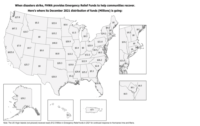In recent weeks, President Trump has let it be known that he no longer foresees public-private partnerships as the centerpiece of his infrastructure plan. No surprise there. The president will look for “shovel-ready” projects and understands that P3s are complicated and don’t always work. But a few days later, we learned that another Australian P3 gone bad is headed for court—the second or third troubled P3 in that country, depending how you count (ENR 10/23 p. 10). There is a link between these two apparently separate events in Washington, D.C., and Brisbane: flawed traffic-flow forecasts, which have doomed several P3 projects around the world and soured the atmosphere surrounding transportation P3s, especially in the U.S.
The issue has a long history. In 2006, The Denver Post reviewed 23 toll roads built since 1985 and found that five of them “sold bonds based on projections prepared by companies promised or granted future business after their projects made sense to investors.” Summing up the views of the experts and critics cited in the article, the Post writer said, “The arrangements raise questions about the objectivity of the traffic and revenue study.”
Serious scholarly studies expanded on the critical journalism. In 2009, Robert Bain, a consultant to Standard & Poor’s, an expert witness and a longtime critic of advocacy forecasting, released his study of confidential traffic and revenue forecast data from more than 100 projects and found that the forecasts were characterized by large errors and a bias toward optimism.
“Toll-road investors need to be aware of the considerable potential for error and bias to influence future projections of asset usage,” Bain wrote. Privatization deals have to incorporate flexibility and enough liquidity in case the forecast proved wrong, he stated.
In a 2012 study for the Australian Dept. of Infrastructure and Transport, Bain noted the need to stop toll-road concessionaires from overbidding. In their eagerness to beat out competitors, concessionaires bid beyond an asset’s worth through overly optimistic projections for traffic and revenue, he stated. In turn, that can lead to “dampening enthusiasm for subsequent private-sector investment,” Bain added.
What these studies predicted seems to have happened. In Texas, where privatized roads once seemed likely to flourish, the state’s first public-private highway venture, SH 130 Concession Co., filed in 2016 for Chapter 11 protection from creditors. It had developed a 41-mile southern section of the state-owned Highway 130 toll road between Austin and San Antonio.
As ENR has reported (ENR 8/22/16 p. 8) that bankruptcy put a new focus on the inexact science of predicting traffic flow.
That project’s shortcomings were consistent with what has happened in other privately financed toll projects: The recession cut down on driving, and motorists chose to skip toll roads with surprising determination. Texas has seemed to lose some of its enthusiasm for P3 toll roads.
To be sure, forecasting is an evolving science. Mark Burris, associate head of Texas A&M University’s Transportation Institute, told ENR last year that traffic forecasting techniques have grown in precision and sophistication to provide the information needed to create more-accurate traffic models. But all the reports come with disclaimers about everything from motorist behavior to economic shifts.
There have been some hard lessons about giving developers and P3 concessionaires only the information that they want to hear. As engineering consultants have learned, best-case scenarios, whether related to demand for transportation or energy projects, are the ones that eager developers will act upon. When things go south, there is no disclaimer or indemnification that will shield consultants from lawsuits and liability.
Privatization projects were always complicated and should not supplant direct government funding for the majority of transportation public works. But when necessary and used appropriately, P3s remain an important and successful development process around the world. In the future, no traffic-flow forecast should be used that hasn’t been peer-reviewed. And no consultant that performs a forecast should be awarded a role on the same project. Until then, bad forecasts will give P3 opponents compelling examples to justify their arguments.
Deputy Editor Richard Korman is the Viewpoint editor of ENR and can be reached at kormanr@enr.com.
If you have an idea for a column, please contact Viewpoint Editor Richard Korman at kormanr@enr.com.




Post a comment to this article
Report Abusive Comment